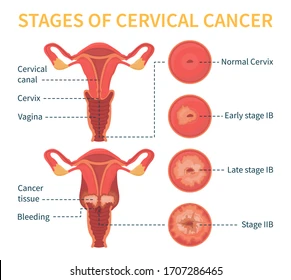The majority of cervical cancers grow gradually over several years with precancerous cells (dysplasia) existing previous to the cancer cells. If dysplasia is detected early enough and removed, cervical cancer can often be prevented. Cervical cancer was once one of the most common causes of cancer death for women. A recent World Health Organization (WHO) survey found more than 48 per cent of countries reported at least partial disruption to cancer treatment.
Another study found that global HPV vaccination rates fell from 15 per cent in 2019 to 13 per cent in 2020, amidst health service disruptions and school closures. In the Commonwealth, which represents 30 per cent of the world’s population and carries a 36 percent share of the global cancer incidence burden, these figures are concerning. However, the cervical cancer death rate has declined by 74 percent. The main reason for this change is the increased use of the Pap test. This screening procedure can find changes in the cervix before cancer develops. It can also find early cervical cancer in its most curable stage. The death rate from cervical cancer continues to decline by 4 percent a year.

A vaccine to prevent cervical cancer was made available in 2008 and is recommended for girls about the time they begin menstruation. The vaccines, Cervarix and Gardasil, have been approved in Nigeria for use. There is a good chance that this cancer will be eradicated in the future if all women get vaccinated. However, use of the vaccine is associated with an unusually high rate of dizziness and blood clotting problems. More study is needed on the risks and benefits of this vaccine.
Causes and Risk Factors
Most cervical cancers are associated with infection with human papillomavirus (HPV), which can be transmitted sexually. Associated risk factors include having had more than five complete pregnancies; first intercourse before age eighteen; unprotected sex; sexually transmitted infections, including HIV, HPV, and genital herpes; early childbearing; multiple sex partners; infertility; low socioeconomic status; smoking; and nutritional deficiencies.
Signs and Symptoms
Cervical cancer usually causes no symptoms until it is advanced, which is why it is essential for women to have regular pelvic exams and Pap tests. It can cause bleeding between menstrual periods, bleeding after intercourse or douching, unusual discharge, painful menstrual periods, and heavy periods.
Detection and Diagnosis
The presence of abnormal cells can be detected by a Pap test, followed up with a biopsy. Women should begin having annual pelvic exams and Pap tests when sexually activity begins, or at age eighteen (after three or more normal exams, your doctor may recommend decreasing the frequency of the exams unless you have had dysplasia or are at an increased risk for other reasons). Screening for HPV is a method of early detection.
Screening for cervical cancer
The goal of cervical cancer screening is to detect cell changes on your cervix before they become cancer. The number of cases and deaths from cervical cancer has decreased significantly since people have been getting regular cervical cancer screenings.
- Pap test: This test detects abnormal or irregular cells in your cervix.
- HPV test: This test detects the high-risk types of HPV infection that are most likely to cause cervical cancer.
Your healthcare provider may suggest a combination Pap test/HPV test. This is called co-testing and may be an option for you if you are over 30.
What are the stages of cervical cancer?
- Stage I: Cancer is found only in your cervix. It hasn’t spread and is small.
- Stage II: Cancer has spread beyond your cervix and uterus but hasn’t yet spread to your pelvic wall (the tissues that line the part of the body between your hips) or your vagina.
- Stage III: Cancer has spread to the lower part of your vagina and may have spread to your pelvic wall, ureters (tubes that carry urine) and nearby lymph nodes.
- Stage IV: Cancer has spread to your bladder, rectum or other parts of the body like your bones or lungs.

Dietary and Nutritional Factors
A diet low in fatty meats (especially cold cuts), red meat, cheeses, and white bread, and high in soy products, fruits, dark green vegetables, tomatoes, whole grains, and yogurt, offers the best dietary protection. Shiitake mushrooms are also a good source of protection.
If you do not consume three to five servings of fruits and vegetables daily, you should take vitamin C (500-1,000 milligrams daily), E, A, and beta-carotene (25,000-50,000 international units daily) in supplemental form, Folic acid, one of the B vitamins (400-800 micrograms daily), can not only aid in prevention, but it has been known to reverse precancerous changes in cervical cells. You can get all these supplements at our store House 2 F8 Street Citec Estate Mbora off Jabi-Airport road Abuja or order for it on www.uandnature.com.



I was very pleased to uncover this web site. I want to to thank you for your time due to this fantastic read!! I definitely appreciated every bit of it and I have you bookmarked to look at new things on your website.